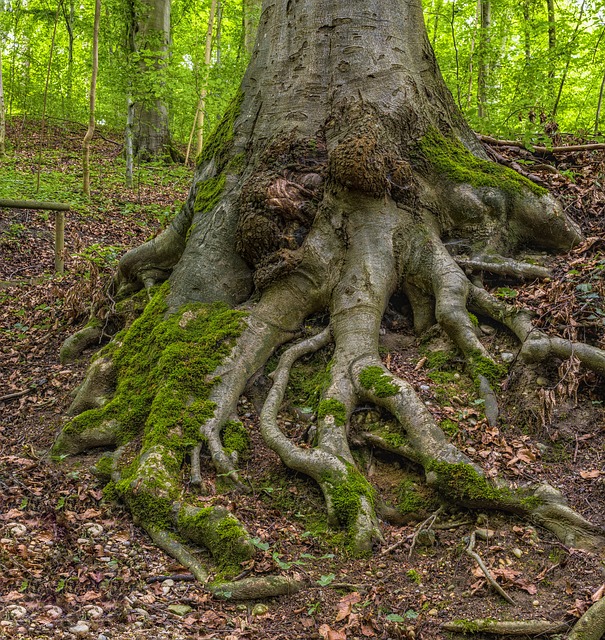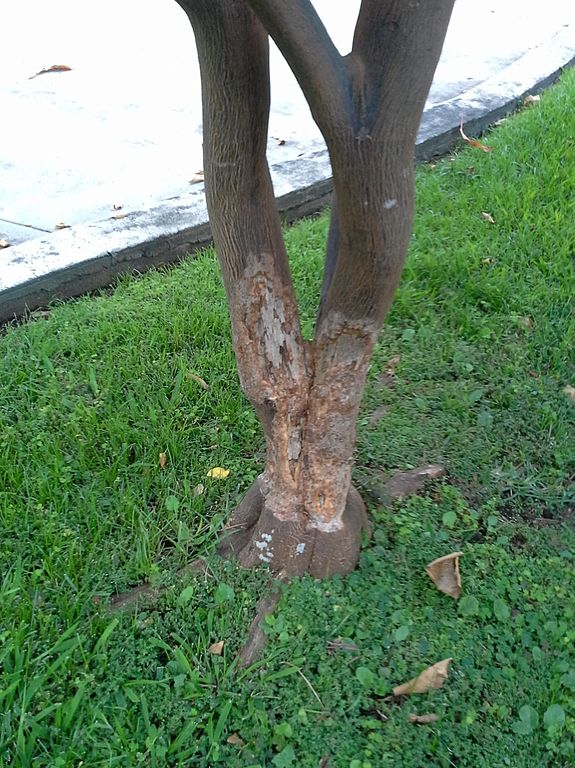Difference Between Root and Stem

What is Root?
The root is a major vegetative organ of the vascular plants, attaching them to the substrate. The roots are typically underground.
The main functions of the root are:
- Anchoring of the plant;
- Absorption of water;
- Storage of nutrients;
- Unlimited growth;
- Vegetative propagation.
The root is best developed in seed plants.
The development of the root begins from the primary root in the embryo, called radicle. When germinated, it breaks through the seed coat and enters the soil.
Depending on their origin and development the roots are:
- Main root – formed by the radicle;
- Lateral (side) roots – come out of the main root or its branches;
- Adventitious roots – formed by other organs of the plant.
In shape, the roots can be:
- Spindle-shaped;
- Globular;
- Cylindrical;
- Conical, etc.
The roots of the plant form its root system. The distribution of the root system in the soil is determined by the hereditary features of the plant and the soil conditions. Root systems are:
- Tap root system – the main root is well developed and overtakes the lateral roots;
- Fibrous root system – the main root is weakly developed or dies, the lateral roots form the root system.
The total surface of the roots exceeds 5-15 times the aboveground part of the plant.
The anatomy of the root is simpler than that of the stem. The reasons for this are:
- The soil environment is with more equal conditions;
- The root does not bear leaves and buds (with few exceptions);
- Endogenous branching;
- Ontogenetically originates from the radicle.
The root consists of the following sections:
- Root tip with a root cap;
- Area of growth;
- Area with root hairs;
- Branching zone.
Under the influence of the environmental conditions, the roots undergo a number of changes (metamorphoses) in shape, structure, and function. Some of the root metamorphoses are:
- Root tubers – storage organs in the lateral roots;
- Photosynthetic roots;
- Aerial roots – absorb water directly from the air;
- Aerating roots – in plants in flooded or swampy habitats, poor in oxygen;
- Stilt roots – adventitious support roots, growing down from lateral branches, reaching the soil;
- Contractile roots – upon depletion of glucose they shrink by 30-40% and insert the plants deep into the soil;
- Bacterial tubers – caused by symbiotic bacteria of the genus Rhizobium;
- Haustorial roots – in parasitic and semi-parasitic plants, etc.

What is Stem?
The stem is a major vegetative organ in the vascular plants, supporting other organs (such as buds, leaves or fruits). In the most plants, the stems are located above the soil surface.
The main functions of the stem are:
- Mechanical support and appropriate arrangement of branches and leaves;
- Transport of the fluids and nutrients;
- Storage of nutrients;
- Production of new tissues/organs;
- Unlimited growth.
Morphologically the stem consists of:
- Nodes – hold leaves and buds;
- Internodes – located between two nodes;
- Apical and axillary buds – can grow into branches.
The stem develops from an apical meristematic tissue, known as a vegetative cone. It grows upwards, showing negative geotropism. The stem grows in length. In most plants it grows also in width and produces branches. Growth occurs through the terminal bud, which consists of meristematic tissue, from which all the cells and tissues of the stem originate.
Very short branches in relative rest are called buds. They can be:
- Apical buds;
- Lateral buds;
- Collateral buds;
- Winter and sleeping buds;
- Leaf, flower and mixed buds;
- Adventitious buds, etc.
Young and unbranched stems with buds and leaves are called branches. The lateral branches appear from the lateral buds with the stem growth.
The shape of the stem can be:
- Round;
- Triangle;
- Polygonal;
- Flat;
- Quadrangle, etc.
The position of the stems can be:
- Erected;
- Creeping;
- Trailing;
- Climbing.
The totality of all aboveground parts of the plant (leaves, stems, and reproductive structures) is called crown.
Depending on their height and density, the crowns are:
- Low or high;
- Dense or loose.
There is a great variety of crown shapes:
- Pyramidal;
- Cylindrical;
- Conical;
- Ellipsoidal;
- Spherical;
- Irregular, etc.
By Habitus and crown dimensions the plants are grouped into the following groups:
- Trees;
- Shrubs;
- Semi-shrubs;
- Grass plants;
- Lianas.
Under the influence of the environmental conditions, the stems undergo a number of changes. Important metamorphoses of the stem are as follows:
- Tubers – truncated thick branches; storage of nutrients; organs of vegetative propagation;
- Rhizomes – underground chlorophyll-free stems; storage of nutrients; organs of vegetative propagation.
- Bulbs – underground and above ground; storage of nutrients; organs of vegetative propagation.
- Runners – underground and above ground; organs of vegetative propagation;
- Thorns – short branches with a sharp tip; protective organs;
- Succulent stems – stems with specialized fleshy, soft and juicy tissues; storage of water, etc.
Difference Between Root and Stem
-
Definition
Root: The root is a major vegetative organ of the vascular plants, attaching them to the substrate. The roots are typically underground.
Stem: The stem is a major vegetative organ in the vascular plants, supporting other organs (such as buds, leaves or fruits). In the most plants, the stems are located above the soil surface.
-
Development
Root: The development of the root begins from the primary root in the embryo, called radicle. When germinated, it breaks through the seed coat and enters the soil.
Stem: The stem develops from an apical meristematic tissue, known as a vegetative cone.
-
Function
Root: The main functions of the root are anchoring of the plant, absorption of water, storage of nutrients, unlimited growth, and vegetative propagation.
Stem: The main functions of the stem are mechanical support and appropriate arrangement of branches and leaves, transport of the fluids and nutrients, storage of nutrients, production of new tissues/organs, and unlimited growth.
-
Shape
Roots: In shape, the root can be spindle-shaped, globular, cylindrical, conical, etc.
Stem: In shape, the stem can be round, triangle, polygonal, flat, quadrangle, etc.
-
Divisions
Root: Depending on their origin and development there are main, lateral and adventitious roots.
Stem: Usually only the main body of the plant is called stem. The young and unbranched stems with buds and leaves are called branches. Very short branches in relative rest are called buds.
-
Sections
Root: The root consists of root tip with a root cap, area of growth, area with root hairs, branching zone.
Stem: The stem consists of nodes, internodes, apical and axillary buds.
-
Surface
Root: The surface of the roots exceeds 5-15 times the aboveground part of the plant.
Stem: The surface of the stem is significantly less than root’s one.
-
Metamorphoses
Root: Root metamorphoses are root tubers, photosynthetic roots, aerial roots, aerating roots, stilt roots, contractile roots, bacterial tubers, haustorial roots, etc.
Stem: Stem metamorphoses are tubers, rhizomes, bulbs, runners, thorns, succulent stems, etc.
-
Formation
Root: The roots of the plant form its root system. Root systems are two types – tap root system and fibrous root system.
Stem: The totality of all aboveground parts of the plant (leaves, stems, and reproductive structures) is called crown. There is a great variety of crown shapes and sizes.
-
Tropism
Root: The root grows downwards, showing positive geotropism.
Stem: The stem grows upwards, showing negative geotropism.
Difference Between Root and Stem: Comparison Chart

Summary of Root vs Stem
- The root is a major vegetative organ of the vascular plants, attaching them to the substrate. The roots are typically underground.
- The stem is a major vegetative organ in the vascular plants, supporting other organs (buds, leaves, fruits). In the most plants, the stems are located above the soil surface.
- The root develops from the radicle, while the stem develops from the vegetative cone.
- The main functions of the root are anchoring of the plant, absorption of water, storage of nutrients, unlimited growth, and vegetative propagation. The main functions of the stem are mechanical support and appropriate arrangement of branches and leaves, transport of the fluids and nutrients, storage of nutrients, production of new tissues/organs, and unlimited growth.
- In shape, the root can be spindle-shaped, globular, cylindrical, conical, etc. The stems are round, triangle, polygonal, flat, quadrangle, etc.
- Depending on their origin and development the roots are main, lateral and adventitious, and the stems are stem, buds, and branches.
- The root consists of root tip with a root cap, area of growth, area with root hairs, branching zone. The stem consists of nodes, internodes, apical and axillary buds.
- The surface of the roots exceeds 5-15 times the aboveground part of the plant.
- Under the influence of the environmental conditions, the roots and stems undergo a number of different changes (metamorphoses) in shape, structure, and function.
- The roots of the plant form its root system. The totality of all aboveground parts of the plant forms its crown.
- The root shows positive geotropism, the stem shows negative geotropism.
- Difference Between Gallstones and Cholecystitis - September 5, 2021
- Difference Between Constipation and Cramping - August 4, 2021
- Difference Between Whole Genome Sequencing and Microarray - May 6, 2021
Search DifferenceBetween.net :
1 Comment
Leave a Response
References :
[0]Barthelemy, D., Y. Caraglio. Plant architecture: a dynamic, multilevel and comprehensive approach to plant form, structure and ontogeny. London: Annals of Botany. 2007: 375–407. Print.
[1]Kozhuharova, K., K. Stoyanov, Ts. Raycheva. Anatomy and Morphology of Plants. Plovdiv: Academic Publishing House of the Agricultural University. 2011. Print.
[2]Neuhaus, G. Morphology and Anatomy of Vascular Plants. Berlin: Springer. 2013. Print.
[3]Image credit: https://upload.wikimedia.org/wikipedia/commons/thumb/d/d4/Bark_peeling_and_stem_blight_or_stem_canker_of_citrus_%2815989626191%29.jpg/575px-Bark_peeling_and_stem_blight_or_stem_canker_of_citrus_%2815989626191%29.jpg
[4]Image credit: https://upload.wikimedia.org/wikipedia/commons/thumb/d/d4/Bark_peeling_and_stem_blight_or_stem_canker_of_citrus_%2815989626191%29.jpg/575px-Bark_peeling_and_stem_blight_or_stem_canker_of_citrus_%2815989626191%29.jpg

nice